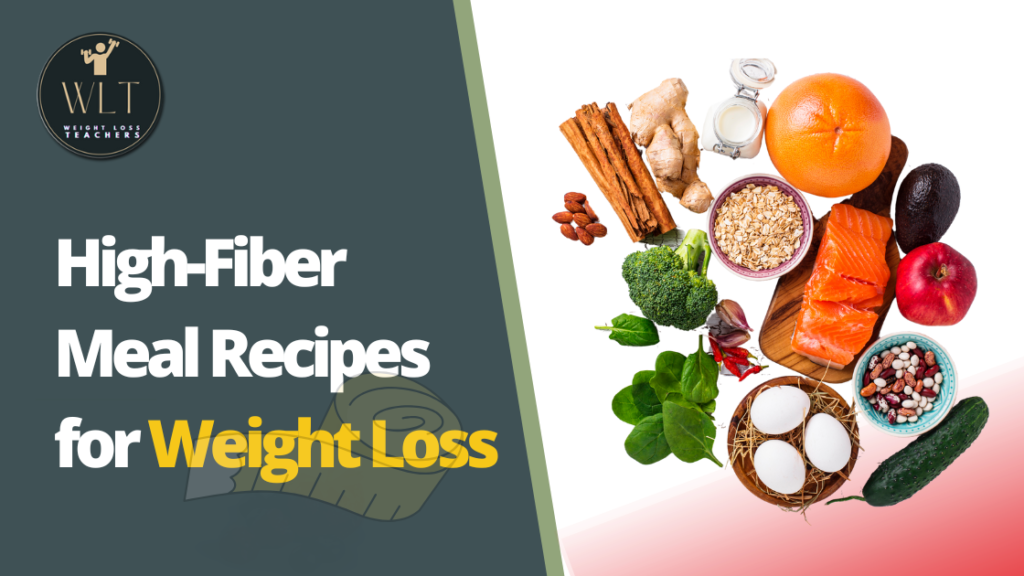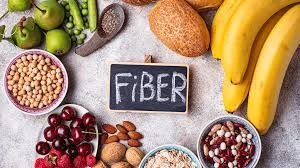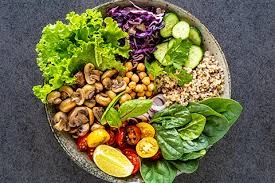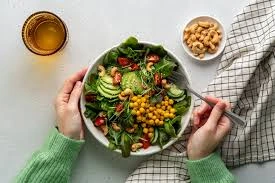
High-Fiber Meal Recipes for Weight Loss

People greatly respect their health, so technology has become a primary tool for weight loss. Wearable fitness trackers could be your closest friend whether you’re just starting or now live healthier.
Table of Contents
Introduction
Fiber is often overlooked when discussing the essential nutrients our bodies require for optimal health. However, its role cannot be overstated. Fiber is a type of carbohydrate that cannot be broken down by the body’s digestive enzymes, and it plays a crucial role in various aspects of our well-being. In this comprehensive exploration, we will delve into the significance of fiber in maintaining good health and promoting weight loss. We will discuss what fiber is, its different types, and why it is important for weight management. By the end of this discussion, you will have a profound understanding of how fiber can be a game-changer in your quest for a healthier and more balanced lifestyle.

What is Fiber?

Before we dive into the numerous health benefits of fiber, let’s start by understanding what fiber is. Fiber is a type of carbohydrate found in plant-based foods. Unlike other carbohydrates such as sugars and starches, fiber cannot be digested by the human body’s enzymes. Instead, it passes through the digestive system largely intact.
There are two primary types of fiber: soluble fiber and insoluble fiber. Each type has unique properties and benefits.
- Soluble Fiber: Soluble fiber dissolves in water, forming a gel-like substance in the digestive system. This type of fiber is found in various foods, including oats, barley, beans, lentils, fruits (such as apples and oranges), and vegetables (like carrots and sweet potatoes). The gel-like consistency of soluble fiber slows down the digestion process, which has several important implications for our health.
- Insoluble Fiber: In contrast to soluble fiber, insoluble fiber does not dissolve in water. Instead, it remains relatively unchanged as it moves through the digestive tract. Insoluble fiber adds bulk to the stool, helping to prevent constipation and promoting regular bowel movements. This type of fiber is commonly found in whole grains, nuts, seeds, and the skin of many fruits and vegetables.
Now that we understand the basic types of fiber, let’s explore why fiber is crucial for maintaining good health and how it can facilitate weight loss.
The Role of Fiber in Weight Loss

Promoting Satiety
One of the primary reasons why fiber is essential for weight loss is its ability to promote a feeling of fullness and satisfaction. Foods rich in fiber take longer to chew and digest, and they have a greater volume relative to their calorie content. As a result, when you consume fiber-rich foods, you tend to feel more satiated and less inclined to overeat.
Imagine having a bowl of oatmeal for breakfast. Oats are an excellent source of soluble fiber. When you consume oatmeal, the soluble fiber in it forms a gel-like substance in your stomach, slowing down the emptying of your stomach contents. This prolonged feeling of fullness can help you avoid snacking or overindulging later in the day.
Reducing Caloric Intake
Fiber-rich foods, particularly fruits, vegetables, and whole grains, are often low in calories. This means that you can consume larger portions of these foods without significantly increasing your overall calorie intake. For individuals trying to lose weight or maintain a healthy weight, this is advantageous because it allows them to enjoy satisfying meals without exceeding their daily calorie limits.
For example, consider a salad made with leafy greens, tomatoes, cucumbers, and other vegetables. This salad is not only rich in fiber but also low in calories. You can eat a substantial portion of the salad without consuming an excessive amount of calories, making it an excellent choice for weight management.
Regulating Blood Sugar Levels
Fiber plays a key role in regulating blood sugar levels. Soluble fiber, in particular, can slow the absorption of sugar, preventing rapid spikes and crashes in blood glucose levels. This steadier blood sugar profile can reduce cravings for sugary and high-calorie foods, making it easier to stick to a calorie-controlled diet.
Individuals with diabetes or those at risk of developing diabetes can benefit significantly from a high-fiber diet. By stabilizing blood sugar levels, fiber helps manage the condition and reduce the risk of complications associated with uncontrolled blood sugar.
Promoting Healthy Digestion
Fiber is essential for maintaining a healthy digestive system. Insoluble fiber, in particular, adds bulk to the stool, softening it and promoting regular bowel movements. This helps prevent constipation and ensures that waste is efficiently eliminated from the body.
A well-functioning digestive system is crucial for overall health and can have a direct impact on weight management. When your digestive system is working optimally, you are more likely to absorb nutrients efficiently and avoid the discomfort and bloating associated with digestive issues.
Preventing Overeating and Emotional Eating
Fiber-rich foods are not only physically filling but can also contribute to a sense of psychological satisfaction. Many people engage in emotional eating, consuming food as a way to cope with stress, anxiety, or other emotions. High-fiber foods, by promoting satiety and a feeling of fullness, can help reduce the inclination to turn to food for emotional comfort.
Moreover, a diet rich in fiber can encourage mindful eating. When you savor and appreciate the textures and flavors of fiber-rich foods, you are less likely to rush through meals or mindlessly consume empty-calorie snacks.
Supporting Gut Health
Fiber is known to be a prebiotic, meaning it provides nourishment for beneficial gut bacteria. These bacteria play a vital role in maintaining a healthy gut microbiome, which is linked to various aspects of overall health, including weight management.
Emerging research suggests that the composition of the gut microbiome can influence metabolism and body weight. Fiber-rich foods can help foster a diverse and thriving community of gut bacteria, potentially aiding in weight control and metabolic health.
The Health Benefits of Fiber Beyond Weight Loss

While the role of fiber in weight management is significant, its health benefits extend far beyond this aspect. Let’s explore some of the additional ways in which fiber contributes to overall well-being:
- Heart Health: A high-fiber diet has been associated with a reduced risk of heart disease. Soluble fiber, in particular, has been shown to lower LDL (bad) cholesterol levels. By binding to cholesterol particles in the digestive tract and promoting their excretion, soluble fiber can help maintain healthy cholesterol levels, reducing the risk of atherosclerosis and heart attacks.
- Diabetes Management: For individuals with diabetes or those at risk of developing the condition, fiber can be a valuable ally. As mentioned earlier, fiber helps regulate blood sugar levels, preventing rapid spikes and crashes. This stability in blood sugar is crucial for diabetes management and can reduce the need for medication in some cases.
- Colon Health: Insoluble fiber plays a vital role in promoting colon health. It adds bulk to the stool, which helps prevent constipation and reduces the risk of conditions like diverticulitis and hemorrhoids. Additionally, a high-fiber diet may lower the risk of colorectal cancer, although more research is needed to fully understand this relationship.
- Weight Maintenance: Beyond aiding in weight loss, fiber is essential for weight maintenance. Many individuals who successfully lose weight struggle to keep it off in the long term. A high-fiber diet can help by promoting satiety and preventing the rebound weight gain that often occurs after a period of calorie restriction.
- Skin Health: Fiber-rich foods, such as fruits and vegetables, are packed with vitamins, minerals, and antioxidants that can promote healthy skin. Antioxidants help protect skin cells from damage caused by free radicals, which can contribute to premature aging. A diet rich in fiber can support clear and radiant skin.
Longevity: Some research suggests that a high-fiber diet may be associated with a longer life. This longevity benefit could be attributed to the various ways in which fiber supports overall health, from heart health to diabetes prevention.
Note: There might be affiliate links mentioned here. We may receive a commission if you purchase a product through an affiliate link. There is no additional charge for you. Please do your own research before making any online purchases.
Incorporating Fiber into Your Diet

Now that we have a comprehensive understanding of why fiber is crucial for maintaining good health and promoting weight loss, let’s discuss how to incorporate more fiber into your diet:
- Start Gradually: If your current diet is low in fiber, it’s essential to introduce it gradually to avoid digestive discomfort. Sudden increases in fiber intake can lead to bloating and gas. Begin by incorporating one or two fiber-rich foods into your daily meals and gradually increase your intake over time.
- Choose Whole Foods: Opt for whole, minimally processed foods to get the most fiber. Whole grains like brown rice, quinoa, and whole wheat bread, as well as fresh fruits and vegetables, are excellent sources of fiber. These foods also provide a wide range of other essential nutrients.
- Experiment with Legumes: Legumes, including beans, lentils, and chickpeas, are exceptional sources of fiber and plant-based protein. They can be added to soups, salads, and various dishes to increase your daily fiber intake.
- Snack Smart: Instead of reaching for sugary or processed snacks, choose fiber-rich options like nuts, seeds, or whole fruit. These snacks can help satisfy your hunger and keep your energy levels stable throughout the day.
- Read Labels: When shopping for packaged foods, read the nutrition labels to identify products that are high in fiber. Look for items that contain whole grains and minimal added sugars.
- Stay Hydrated: As you increase your fiber intake, it’s essential to drink plenty of water. Fiber absorbs water and can become more effective in promoting regular bowel movements when combined with adequate hydration.
- Diversify Your Diet: Variety is key to a healthy diet. Experiment with different types of fiber-rich foods to keep your meals interesting and enjoyable. Try new recipes and explore cuisines from around the world to discover new sources of fiber.
Fiber Rich Recipes for Weight Loss

Now that we’ve covered the basics of the fiber, let’s take a look at some delicious fiber rich recipes that are perfect for weight loss.
Quinoa and Black Bean Salad
Quinoa is a high-fiber grain that is also rich in protein, making it an excellent choice for weight loss. This salad is packed with fiber, protein, and healthy fats, making it a satisfying and nutritious meal.
Ingredients:
- 1 cup quinoa, rinsed and drained
- 1 can black beans, drained and rinsed
- 1 red bell pepper, diced
- 1 yellow bell pepper, diced
- 1 cup cherry tomatoes, halved
- 1 avocado, diced
- ¼ cup cilantro, chopped
- 2 tablespoons olive oil
- 2 tablespoons lime juice
- 1 teaspoon cumin
- Salt and pepper to taste
Instructions:
- Cook quinoa according to package instructions and let cool.
- In a large bowl, combine the quinoa, black beans, bell peppers, cherry tomatoes, avocado, and cilantro.
- In a small bowl, whisk together the olive oil, lime juice, cumin, salt, and pepper.
- Pour the dressing over the salad and toss to combine.
- Serve chilled.
Chickpea and Spinach Curry
Chickpeas are a high-fiber source of plant-based protein and are a great addition to a weight loss diet. This curry is packed with flavor and fiber, making it a satisfying and nutritious meal.
Ingredients:
- 1 tablespoon coconut oil
- 1 onion, diced
- 2 garlic cloves, minced
- 1 tablespoon grated ginger
- 2 teaspoons ground cumin
- 2 teaspoons ground coriander
- ½ teaspoon turmeric
- 1 can chickpeas, drained and rinsed
- 1 can diced tomatoes
- 1 cup vegetable broth
- 2 cups spinach
- Salt and pepper to taste
Instructions:
- In a large saucepan, heat the coconut oil over medium heat.
- Add the onion, garlic, and ginger and sauté for 5 minutes or until the onion is soft and translucent.
- Add the cumin, coriander, and turmeric and sauté for an additional minute.
- Add the chickpeas, diced tomatoes, and vegetable broth and bring to a simmer.
- Simmer for 10-15 minutes, or until the sauce has thickened slightly.
- Add the spinach and stir until wilted.
- Season with salt and pepper to taste
- Serve hot with brown rice
Lentil Soup
Lentils are an excellent source of fiber and protein, making them a great addition to a weight loss diet. This lentil soup is hearty, flavorful, and packed with fiber and nutrients.
Ingredients:
- 1 tablespoon olive oil
- 1 onion, diced
- 2 garlic cloves, minced
- 1 teaspoon cumin
- 1 teaspoon coriander
- 1 teaspoon smoked paprika
- 1 cup red lentils, rinsed and drained
- 4 cups vegetable broth
- 1 can diced tomatoes
- 2 cups chopped kale
- Salt and pepper to taste
Instructions:
- In a large pot, heat the olive oil over medium heat.
- Add the onion and garlic and sauté for 5 minutes, or until the onion is soft and translucent.
- Add the cumin, coriander, and smoked paprika and sauté for an additional minute.
- Add the lentils, vegetable broth, and diced tomatoes and bring to a boil.
- Reduce heat to low and simmer for 20-25 minutes, or until the lentils are tender.
- Add the kale and stir until wilted.
- Season with salt and pepper to taste.
- Serve hot.
Chickpea and Sweet Potato Stew
Sweet potatoes are a good source of fiber and vitamins, making them a nutritious addition to any meal. This stew is packed with fiber, protein, and healthy fats, making it a satisfying and delicious meal.
Ingredients:
- 1 tablespoon olive oil
- 1 onion, diced
- 2 garlic cloves, minced
- 1 teaspoon ground cumin
- 1 teaspoon ground coriander
- ½ teaspoon smoked paprika
- 2 sweet potatoes, peeled and diced
- 1 can chickpeas, drained and rinsed
- 4 cups vegetable broth
- Salt and pepper to taste
Instructions:
- In a large pot, heat the olive oil over medium heat.
- Add the onion and garlic and sauté for 5 minutes, or until the onion is soft and translucent.
- Add the cumin, coriander, and smoked paprika and sauté for an additional minute.
- Add the sweet potatoes, chickpeas, and vegetable broth and bring to a boil.
- Reduce heat to low and simmer for 20-25 minutes, or until the sweet potatoes are tender.
- Season with salt and pepper to taste.
- Serve hot.
Whole Wheat Pasta with Broccoli and Garlic
Whole wheat pasta is a good source of fiber and complex carbohydrates, making it a healthier choice than traditional white pasta. This pasta dish is packed with fiber and nutrients, making it a satisfying and nutritious meal.
Ingredients:
- 8 ounces whole wheat pasta
- 2 cups broccoli florets
- 2 garlic cloves, minced
- 2 tablespoons olive oil
- Salt and pepper to taste
- Parmesan cheese for serving (optional)
Instructions:
- Cook the pasta according to package instructions and drain.
- In a large skillet, heat the olive oil over medium heat.
- Add the broccoli and sauté for 5-7 minutes, or until tender.
- Add the garlic and sauté for an additional minute.
- Add the cooked pasta to the skillet and toss to combine.
- Season with salt and pepper to taste.
- Serve hot with grated Parmesan cheese, if desired.
Berry and Yogurt Parfait
Berries are a good source of fiber and antioxidants, making them a healthy addition to any meal. This parfait is packed with fiber, protein, and healthy fats, making it a satisfying and delicious dessert or breakfast option.
Ingredients:
- 1 cup plain Greek yogurt
- 1 cup mixed berries (strawberries, blueberries, raspberries)
- 1/4 cup granola
- 1 tablespoon honey
Instructions:
- In a small bowl, mix together the Greek yogurt and honey.
- In a glass or parfait dish, layer the yogurt mixture, mixed berries, and granola.
- Repeat until all ingredients are used up, ending with a layer of mixed berries.
- Serve immediately.
FAQs (Frequently Asked Questions)
Q1. What is fiber, and why is it important for our health?
A1. Fiber is a type of carbohydrate found in plant-based foods that cannot be digested by the body’s enzymes. It is important for our health because it plays a crucial role in various aspects of our well-being, including digestion, weight management, heart health, and more.
Q2. What are the two primary types of fiber, and how do they differ?
A2. There are two primary types of fiber: soluble fiber and insoluble fiber. Soluble fiber dissolves in water, forming a gel-like substance in the digestive system, while insoluble fiber does not dissolve in water and adds bulk to the stool.
Q3. How does soluble fiber promote a feeling of fullness and assist in weight loss?
A3. Soluble fiber forms a gel-like substance in the stomach, which slows down the emptying of the stomach contents. This prolonged feeling of fullness can help prevent overeating and snacking, making it easier to manage calorie intake and support weight loss.
Q4. Can you provide an example of a high-fiber food that helps reduce caloric intake?
A4. A great example is a salad made with leafy greens, tomatoes, cucumbers, and other vegetables. It’s rich in fiber and low in calories, allowing you to consume a substantial portion without exceeding your daily calorie limit, which is advantageous for weight management.
Q5. How does fiber help regulate blood sugar levels, and why is this important for weight management?
A5. Soluble fiber, by slowing the absorption of sugar, prevents rapid spikes and crashes in blood glucose levels. Stable blood sugar levels reduce cravings for sugary and high-calorie foods, making it easier to stick to a calorie-controlled diet and support weight management.
Q6. What role does fiber play in promoting healthy digestion?
A6. Insoluble fiber adds bulk to the stool, softening it and promoting regular bowel movements. This helps prevent constipation and ensures efficient waste elimination, which is crucial for overall health and weight management.
Q7. How does a high-fiber diet help prevent overeating and emotional eating?
A7. Fiber-rich foods provide physical and psychological satisfaction, promoting a feeling of fullness. This can reduce the inclination to overeat and turn to food for emotional comfort, ultimately supporting better control of calorie intake.
Q8. Can you explain how fiber supports gut health and its potential impact on weight control?
A8. Fiber acts as a prebiotic, nourishing beneficial gut bacterium. A diverse and thriving gut microbiome, influenced by fiber-rich foods, may aid in weight control and metabolic health by influencing metabolism and body weight.
Q9. Apart from weight loss, what are some other health benefits of a high-fiber diet?
A9. A high-fiber diet is associated with several health benefits, including improved heart health, better diabetes management, colon health, weight maintenance, enhanced skin health, and potentially even increased longevity.
Q10. What are some practical tips for incorporating more fiber into one’s diet?
A10. Gradually introduce fiber to avoid digestive discomfort, choose whole foods, experiment with legumes, opt for smart fiber-rich snacks, read nutrition labels, stay hydrated, and diversify your diet to include various fiber sources such as fruits, vegetables, whole grains, and nuts.
Conclusion
Fiber is an important nutrient that can help with weight loss by keeping you feeling full and satisfied. These high-fiber meal recipes are not only nutritious, but also delicious and easy to make. Incorporating these meals into your diet can help you reach your weight loss goals while also promoting overall health and wellness. Remember to always choose whole, minimally processed foods and listen to your body’s hunger and fullness cues. Happy cooking and enjoy your high-fiber meals!
Disclaimer: The information provided in this article is for educational purposes only and should not be considered as a substitute for medical advice. Consult a healthcare professional before implementing any home remedies or making significant changes to your lifestyle.






